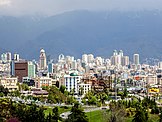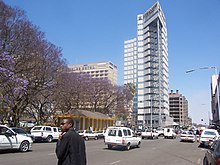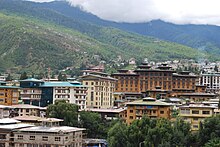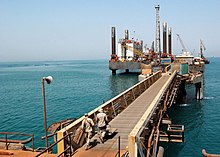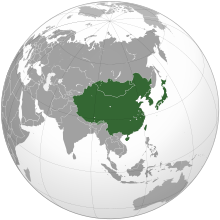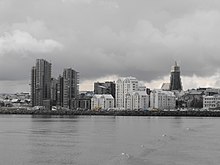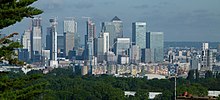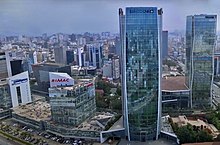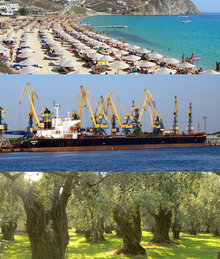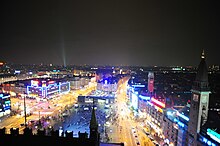Portal:Business/Selected economy
These are articles that are selected for the "Selected economy" slot within the Business and economics portal.
Selected economy 1
Portal:Business/Selected economy/1
The United States is a highly developed country with a market economy and has the world's largest nominal GDP and net wealth. It has the second-largest by purchasing power parity (PPP) behind China. It had the world's eighth-highest per capita GDP (nominal) and the ninth-highest per capita GDP (PPP) in 2022. The United States has the most technologically powerful and innovative economy in the world. Its firms are at or near the forefront in technological advances, especially in artificial intelligence, computers, pharmaceuticals, and medical, aerospace, and military equipment. The U.S. dollar is the currency most used in international transactions and is the world's foremost reserve currency, backed by its economy, its military, the petrodollar system and its linked eurodollar and large U.S. treasuries market. Several countries use it as their official currency and in others it is the de facto currency. The largest U.S. trading partners are China, the European Union, Canada, Mexico, India, Japan, South Korea, the United Kingdom, and Taiwan. The U.S. is the world's largest importer and the second-largest exporter. It has free trade agreements with several countries, including the USMCA, Australia, South Korea, Switzerland, Israel and several others that are in effect or under negotiation. (Full article...)Selected economy 2
Portal:Business/Selected economy/2
The economy of Iran is a mixed economy with a large state-owned sector and is the largest in the Middle east in terms of nominal GDP. It is the world's 23rd largest by purchasing power parity (PPP). Some 60% of Iran's economy is centrally planned. It is dominated by oil and gas production, although over 40 industries are directly involved in the Tehran Stock Exchange. The stock exchange has been one of the best performing exchanges in the world over the past decade. With 10% of the world's proven oil reserves and 15% of its gas reserves, Iran is considered an "energy superpower". (Full article...)Selected economy 3
Portal:Business/Selected economy/3
The economy of Ohio nominally would be the 21st largest global economy behind Saudi Arabia and ahead of Argentina according to the 2017 International Monetary Fund GDP estimates. The state had a GDP of $656.19 billion in 3rd quarter of 2017, up from $517.1 billion in 2012, and up from $501.3 billion in 2011, according to the Bureau of Economic Analysis. In 2013, Ohio was ranked in the top ten states for best business climate by Site Selection magazine, based on a business-activity database. The state was edged out only by Texas and Nebraska for the 2013 Governor's Cup award from the magazine, based on business growth and economic development. (Full article...)Selected economy 4
Portal:Business/Selected economy/4

The economy of Hong Kong is a highly developed free-market economy. It is characterised by low taxation, almost free port trade and a well-established international financial market. Its currency, called the Hong Kong dollar, is legally issued by three major international commercial banks, and is pegged to the US dollar. Interest rates are determined by the individual banks in Hong Kong to ensure that they are market driven. There is no officially recognised central banking system, although the Hong Kong Monetary Authority functions as a financial regulatory authority.
Its economy is governed under positive non-interventionism, and is highly dependent on international trade and finance. For this reason it is regarded as among the most favorable places to start a company. In fact, a recent study shows that Hong Kong has come from 998 registered start-ups in 2014 to over 2800 in 2018, with eCommerce (22%), Fintech (12%), Software (12%) and Advertising (11%) companies comprising the majority. The Economic Freedom of the World Index listed Hong Kong as the number one territory, with a score of 8.97, in 2015. (Full article...)
Selected economy 5
Portal:Business/Selected economy/5

The economy of Singapore is a highly developed free-market economy. Singapore's economy has been ranked by the World Economic Forum as the most open in the world, the 3rd-least corrupt, and the most pro-business. Singapore has low tax-rates and the second-highest per-capita GDP in the world in terms of purchasing power parity (PPP). The Asia-Pacific Economic Cooperation (APEC) is headquartered in Singapore.
Alongside the business-friendly reputation, state-owned enterprises play a substantial role in Singapore's economy. The sovereign wealth fund Temasek Holdings holds majority stakes in several of the nation's largest companies, such as Singapore Airlines, SingTel, ST Engineering and MediaCorp. The Singaporean economy is a major foreign direct investment (FDI) outflow-financier in the world. Singapore has also benefited from the inward flow of FDI from global investors and institutions due to its highly attractive investment climate and a stable political environment in recent years. (Full article...)
Selected economy 6
Portal:Business/Selected economy/6

The economy of the European Union is the joint economy of the member states of the European Union (EU). It is the second largest economy in the world in nominal terms, after the United States, and the third one in purchasing power parity (PPP) terms, after China and the United States. The European Union's GDP was estimated to be around $17.1 trillion (nominal) in 2020, representing around 1/6 of the global economy.
The euro is the second largest reserve currency and the second most traded currency in the world after the United States dollar. The euro is used by 19 of its 27 members, overall, it is the official currency in 25 countries, in the eurozone and in six other European countries, officially or de facto. (Full article...)
Selected economy 7
Portal:Business/Selected economy/7
The economy of the Republic of Ireland is a highly developed knowledge economy, focused on services in high-tech, life sciences, financial services and agribusiness, including agrifood. Ireland is an open economy (5th on the Index of Economic Freedom) and ranks first for high-value foreign direct investment (FDI) flows. In the global GDP per capita tables, Ireland ranks 4th of 186 in the IMF table and 4th of 187 in the World Bank ranking.
Following a period of continuous growth at an annual level from 1984 to 2007, the post-2008 Irish financial crisis severely affected the economy, compounding domestic economic problems related to the collapse of the Irish property bubble. Ireland first experienced a short technical recession from Q2-Q3 2007, followed by a recession from Q1 2008 – Q4 2009. (Full article...)
Selected economy 8
Portal:Business/Selected economy/8

The economy of Libya depends primarily on revenues from the petroleum sector, which represents over 95% of export earnings and 60% of GDP. These oil revenues and a small population have given Libya one of the highest nominal per capita GDP in Africa.
After 2000, Libya recorded favourable growth rates with an estimated 10.6% growth of GDP in 2010. This development was interrupted by the Libyan Civil War, which resulted in contraction of the economy by 62.1% in 2011. After the war, the economy rebounded by 104.5% in 2012. It crashed again following the Second Libyan Civil War. As of 2017, Libya's per capita PPP GDP stands at 60% of its pre-war level. (Full article...)
Selected economy 9
Portal:Business/Selected economy/9

The economy of India is a middle income developing market economy. It is the world's sixth-largest economy by nominal GDP and the third-largest by purchasing power parity (PPP). According to the International Monetary Fund (IMF), on a per capita income basis, India ranked 144th by GDP (nominal) and 128th by GDP (PPP). From independence in 1947 until 1991, successive governments promoted protectionist economic policies, with extensive state intervention and economic regulation. This is characterised as dirigism, in the form of the License Raj. The end of the Cold War and an acute balance of payments crisis in 1991 led to the adoption of a broad economic liberalisation in India. Since the start of the 21st century, annual average GDP growth has been 6% to 7%, and from 2013 to 2018, India was the world's fastest growing major economy, surpassing China. Historically, India was the largest economy in the world for most of the two millennia from the 1st until the 19th century. (Full article...)
Selected economy 10
Portal:Business/Selected economy/10
The economy of Ghana has a diverse and rich resource base, including the manufacturing and exportation of digital technology goods, automotive and ship construction and exportation, and the exportation of diverse and rich resources such as hydrocarbons and industrial minerals. These have given Ghana one of the highest GDP per capita in West Africa. Owing to a GDP rebasement, in 2011 Ghana became the fastest-growing economy in the world.
The Ghanaian domestic economy in 2012 revolved around services, which accounted for 50% of GDP and employed 28% of the work force. Besides the industrialization associated with minerals and oil, industrial development in Ghana remains basic, often associated with plastics (such as for chairs, plastic bags, razors and pens). 53.6% of Ghana's workforce were employed in agriculture in 2013. (Full article...)
Selected economy 11
Portal:Business/Selected economy/11

Selected economy 12
Portal:Business/Selected economy/12

The economy of Brazil is historically the largest in Latin America and the Southern Hemisphere in nominal terms. The Brazilian economy is the third largest in the Americas. The economy is a middle income developing mixed economy that is the twelfth largest in the world by nominal gross domestic product (GDP) and eighth largest by purchasing power parity in 2020.
According to International Monetary Fund (IMF), Brazilian nominal GDP of 2021 was US$1.645 trillion, the country has a long history of being among the ten largest economies in the world. Brazil is the 83rd country in the world in GDP per capita, with a value of US$7,741.15 per inhabitant in 2021. (Full article...)
Selected economy 13
Portal:Business/Selected economy/13
The economy of Macau has remained one of the most open in the world since its handover to China in 1999. Apparel exports and gambling-related tourism are mainstays of the economy. Since Macau has little arable land and few natural resources, it depends on mainland China for most of its food, fresh water, and energy imports. Japan and Hong Kong are the main suppliers of raw materials and capital goods. Although Macau was hit hard by the 1997–98 Asian financial crisis and the early 2000s recession, its economy grew approximately 13.1% annually on average between 2001 and 2006. Macau is a full Member of the World Trade Organization. Public security has greatly improved after handover to the People's Republic of China. With the tax revenue from the profitable gambling industry, the Macau government is able to introduce the social welfare program of 15 years of free education to all Macau citizens. In 2015, Macau's economy saw a sharp decrease (-26.4% year-on-year in Q2 2015) due to the reduced spending by visitors from Mainland China since the Anti-corruption campaign under Xi Jinping. (Full article...)
Selected economy 14
Portal:Business/Selected economy/14

The economy of Mexico is a developing market economy. It is the 15th largest in the world in nominal GDP terms and the 12th largest by purchasing power parity, according to the International Monetary Fund. Since the 1994 crisis, administrations have improved the country's macroeconomic fundamentals. Mexico was not significantly influenced by the 2002 South American crisis, and maintained positive, although low, rates of growth after a brief period of stagnation in 2001. However, Mexico was one of the Latin American nations most affected by the 2008 recession with its gross domestic product contracting by more than 6% in that year. (Full article...)
Selected economy 15
Portal:Business/Selected economy/15

The People's Republic of China has a developing market-oriented economy that incorporates economic planning through industrial policies and strategic five-year plans. The economy consists of state-owned enterprises (SOEs) and mixed-ownership enterprises, as well as a large domestic private sector and openness to foreign businesses in a system officially described as a socialist market economy. State-owned enterprises accounted for over 60% of China's market capitalization in 2019 and generated 40% of China's GDP of US$15.98trillion dollars (101.36 trillion yuan) in 2020, with domestic and foreign private businesses and investment accounting for the remaining 60%. As of the end of 2019, the total assets of all China's SOEs, including those operating in the financial sector, reached US$58.97trillion In 2015`. Ninety-one (91) of these SOEs belong to the 2020 Fortune Global 500 companies. China has the world's second largest economy when measured by nominal GDP, and the world's largest economy since 2014 when measured by Purchasing Power Parity (PPP). It has been the second largest by nominal GDP since 2010, with data relying on fluctuating market exchange rates. It recently overtook the economy of the European Union in 2021. A forecast states that China will become the world's largest economy in nominal GDP by 2028. Historically, China was one of the world's foremost economic powers for most of the two millennia from the 1st until the 19th century. (Full article...)
Selected economy 16
Portal:Business/Selected economy/16
The economy of Myanmar has a nominal GDP of USD $76.09 billion in 2019 and an estimated purchasing power adjusted GDP of USD $327.629 billion in 2017 according to the World Bank. For the 2020 estimate, GDP per capita in Myanmar would be USD $5142.20 in PPP per capita and USD $1,608.50 in nominal per capita. This would make Myanmar the poorest country in Southeast Asia and one of the poorest countries in Asia. (Full article...)
Selected economy 17
Portal:Business/Selected economy/17 The economy of Pakistan is the 25th-largest worldwide in terms of GDP based on purchasing power parity (PPP). According to 2021 estimate, Country has population of 227 million people (5th-largest worldwide), the nominal GDP of Pakistan stands at US$347 billion with a nominal GDP per capita of US$1,562 (172th worldwide); its GDP based on PPP stands at US$1.329 trillion with a GDP (PPP) per capita of US$5,973 (156th worldwide). (Full article...)
Selected economy 18
Portal:Business/Selected economy/18 The economy of Africa consists of the trade, industry, agriculture, and human resources of the continent. , approximately 1.3 billion people were living in 54 countries in Africa. Africa is a resource-rich continent. Recent growth has been due to growth in sales in commodities, services, and manufacturing. West Africa, East Africa, Central Africa and Southern Africa in particular, are expected to reach a combined GDP of $29 trillion by 2050.
In March 2013, Africa was identified as the world's poorest inhabited continent; however, the World Bank expects that most African countries will reach "middle income" status (defined as at least US$1,025 per person a year) by 2025 if current growth rates continue. There are a number of reasons for Africa's poor economy: historically, even though Africa had a number of empires trading with many parts of the world, most people lived in tribal rural societies; in addition, European colonization and the later Cold War created political, economic and social instability. (Full article...)
Selected economy 19
Portal:Business/Selected economy/19
The economy of Zimbabwe mainly relies on its tertiary industry, which makes up to 60% of the total GDP as of 2017. Zimbabwe has the second biggest informal economy as a share of its economy, which has a score of 60.6%. Agriculture and mining largely contribute to exports. The economy of Zimbabwe grew at an average of 12% from 2009 to 2013, rendering it one of the fastest growing economies in the world. It had recovered from its negative growth from 1998 to 2008, before it slowed to 0.7% growth in 2016.
The country has reserves of metallurgical-grade chromite. Other commercial mineral deposits include coal, asbestos, copper, nickel, gold, platinum and iron ore. (Full article...)
Selected economy 20
Portal:Business/Selected economy/20
The economy of Bhutan, one of the world's smallest and least developed countries, is based on agriculture and forestry, which provide the main livelihood for more than 60% of the population. Agriculture consists largely of subsistence farming and animal husbandry. Rugged mountains dominate the terrain and make the building of roads and other infrastructure difficult and expensive.
Bhutan's economy is closely aligned with India's through strong trade and monetary links and dependence on India's financial assistance. Most production in the industrial sector is of the cottage industry type. Most development projects, such as road construction, rely on Indian migrant labour. Model education, social, and environment programs are underway with support from multilateral development organisations. (Full article...)
Selected economy 21
Portal:Business/Selected economy/21
The economy of Iraq is dominated by the oil sector, which has provided about 99.7% of foreign exchange earnings during its modern history. As of 2021, the oil sector provides about 92% of foreign exchange earnings. Iraq's hitherto agrarian economy underwent rapid development following the 14 July Revolution which overthrew the Hashemite Iraqi monarchy. It had become the third-largest economy in the Middle East by 1980. This occurred in part because of the Iraqi government's successful industrialization and infrastructure development initiatives in the 1970s, which included irrigation projects, railway and highway construction, and rural electrification. (Full article...)
Selected economy 22
Portal:Business/Selected economy/22 The economy of South America comprises approximately 430 million people living in twelve nations and three territories. It encompasses 6 percent of the world's population.
From the 1930s to 1980s, countries of South America used Import Substitution, an economic policy that replaces foreign businesses as well as imports with domestic production. This was a policy made to increase domestic manufacturing. Furthermore, national spending on arms soared during periods of military rule. Increasingly South American countries began to borrow from foreign private banks and international lending institutions, such as the World Bank and the Inter-American Development Bank, to fund existing programs while also trying to expand their economic productivity through investments. However, this policy created a debt crisis in South America.
The continent has fallen farther behind North America over the past two centuries. This can be explained by South America's high concentration on primary commodities as well as the state of the educational system and institutional structure, some of which are still related to its colonial past, others to recent political developments. (Full article...)
Selected economy 23
Portal:Business/Selected economy/23 | per capita = $7,351 (2019; 5th) | growth = 5.7% (2017) | millionaires = 5.12 million (2016) | unemployment = 3.8% (2010 est.) | footnote = Most numbers are from the International Monetary Fund. (Full article...)
Selected economy 24
Portal:Business/Selected economy/24
The economy of East Asia comprises 1.6 billion people (20.5% of the world population) living in 6 different countries and regions. It is home to some of the most economically dynamic places in the world, being the site of some of the world's longest modern economic booms, including the Japanese economic miracle (1950–1990), Miracle on the Han River (1961–1996) in South Korea, the Taiwan miracle in Taiwan (1960–1996) and the current economic boom (1978–2015) in Mainland China. The region includes several of the world's largest and most prosperous economies: Japan, South Korea, Mainland China, Taiwan, Hong Kong, and Macau.
East Asia's economic prominence has grown significantly in recent years, increasing its importance and influence in Asia and the world economy. Recent developments have led to an expanding cosmopolitan middle class. East Asian countries are key contributors to major global communications and trade networks, developing relations with other nations, including those of the Western world, making it a significant contributor in the global economy. The region's economic success was referred to as "An East Asian Renaissance" by the World Bank in 2007. (Full article...)
Selected economy 25
Portal:Business/Selected economy/25
The economy of Iceland is small and subject to high volatility. In 2011, gross domestic product was US$12 billion, but by 2018 it had increased to a nominal GDP of US$27 billion. With a population of 350,000, this is $55,000 per capita, based on purchasing power parity (PPP) estimates. The financial crisis of 2007–2010 produced a decline in GDP and employment that has since been reversed entirely by a recovery aided by a tourism boom starting in 2010. Tourism accounted for more than 10% of Iceland's GDP in 2017. After a period of robust growth, Iceland's economy is slowing down according to an economic outlook for the years 2018–2020 published by Arion Research in April 2018.
Iceland has a mixed economy with high levels of free trade and government intervention. However, government consumption is less than other Nordic countries. Hydro-power is the primary source of home and industrial electrical supply in Iceland. (Full article...)
Selected economy 26
Portal:Business/Selected economy/26

The economy of Greenland can be characterized as small, mixed and vulnerable. Greenland's economy consists of a large public sector and comprehensive foreign trade. This has resulted in an economy with periods of strong growth, considerable inflation, unemployment problems and extreme dependence on capital inflow from the Kingdom Government.
GDP per capita is close to the average for European economies, but the economy is critically dependent upon substantial support from the Danish government, which supplies about half the revenues of the Self-rule Government, which in turn employs 10,307 Greenlanders out of 25,620 currently in employment (2015). Unemployment nonetheless remains high, with the rest of the economy dependent upon demand for exports of shrimp and fish. (Full article...)
Selected economy 27
Portal:Business/Selected economy/27

The economy of Canada is a highly developed mixed-market economy. It is the 8th largest GDP by nominal and 15th largest GDP by PPP in the world. As with other developed nations, the country's economy is dominated by the service industry which employs about three quarters of Canadians. Canada has the third-highest total estimated value of natural resources, valued at Int$33.98 trillion in 2019`. It has the world's third largest proven oil reserves and is the fourth largest exporter of crude oil. It is also the fifth largest exporter of natural gas. Canada is considered an "energy superpower" due to its abundant natural resources and a relatively small population of 39 million inhabitants, in relation to its land area.
According to the Corruption Perceptions Index, Canada is perceived as one of the least corrupt countries in the world, and is one of the world's top ten trading nations, with a highly globalized economy. Canada historically ranks above the United States and most western European nations on The Heritage Foundation's index of economic freedom, while experiencing a relatively low level of income disparity. The country's average household disposable income per capita is "well above" the OECD average. The Toronto Stock Exchange is the eighth-largest stock exchange in the world by market capitalization, listing over 1,500 companies with a combined market capitalization of over US$3 trillion. (Full article...)
Selected economy 28
Portal:Business/Selected economy/28
The economy of England is the largest economy of the four countries of the United Kingdom.
England is a highly industrialised country. It is an important producer of textiles and chemical products. Although automobiles, locomotives, and aircraft are among England's other important industrial products, a significant proportion of the country's income comes from the City of London. Since the 1990s, the financial services sector has played an increasingly significant role in the English economy and the City of London is one of the world's largest financial centres. Banks, insurance companies, commodity and futures exchanges are heavily concentrated in the City. The British pound sterling is the official currency of England and the central bank of the United Kingdom, the Bank of England, is located in London. (Full article...)
Selected economy 29
Portal:Business/Selected economy/29
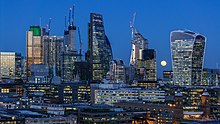
The economy of the United Kingdom is a highly developed social market and market-oriented economy. It is the fifth-largest national economy in the world measured by nominal gross domestic product (GDP), eighth-largest by purchasing power parity (PPP), and twenty fifth-highest by GDP per capita, constituting 3.3% of world GDP.
The UK is one of the most globalised economies, and comprises England, Scotland, Wales and Northern Ireland. In 2019, the UK was the fifth-largest exporter in the world and the fifth-largest importer. It also had the third-largest inward foreign direct investment, and the fifth-largest outward foreign direct investment. In 2020, the UK's trade with the 27 member states of the European Union accounted for 49% of the country's exports and 52% of its imports. (Full article...)
Selected economy 30
Portal:Business/Selected economy/30 The economy of Europe comprises about 748 million people in 50 countries. The formation of the European Union (EU) and in 1999, the introduction of a unified currency, the Euro, brings participating European countries closer through the convenience of a shared currency and has led to a stronger European cash flow. It is important to know the European Union is not a country, rather a global unique organisation, the entity with the biggest economy in the world. The European Union also “regulates” the global market by the Single Market. The difference in wealth across Europe can be seen roughly in former Cold War divide, with some countries breaching the divide (Greece, Estonia, Portugal, Slovenia and the Czech Republic). Whilst most European states have a GDP per capita higher than the world's average and are very highly developed, some European economies, despite their position over the world's average in the Human Development Index, are poorer. Europe has total banking assets of more than $50 trillion and its Global assets under management has more than $20 trillion.
Throughout this article "Europe" and derivatives of the word are taken to include selected states whose territory is only partly in Europe, such as Turkey, Azerbaijan and Georgia, and states that are geographically in Asia, bordering Europe and culturally adherent to the continent, such as Armenia and Cyprus. (Full article...)
Selected economy 31
Portal:Business/Selected economy/31
The Economy of Russia has gradually transformed from a planned economy into a market-oriented economy. It has enormous natural resources, particularly oil and natural gas. As of 2021, it was the fifth-largest economy in Europe, the world's eleventh-largest economy by nominal GDP, and the sixth-largest by PPP.
Russia's vast geography is an important determinant of its economic activity, with the country holding a large share of the world's natural resources. It has been widely described as an energy superpower; as it has the world's largest natural gas reserves, the second-largest coal reserves, the eighth-largest oil reserves, and the largest oil shale reserves in Europe. It is the world's leading natural gas exporter, the second-largest natural gas producer, and the second-largest oil exporter, and producer. Russia's foreign exchange reserves are the world's fifth-largest. It has a labour force of roughly 70 million people, which is the world's sixth-largest. Russia has a large and sophisticated arms industry, capable of designing and manufacturing high-tech military equipment, and is the world's second-largest exporter of arms. Russia also has the world's fifth-largest number of billionaires. (Full article...)
Selected economy 32
Portal:Business/Selected economy/32

Australia is a highly developed country with a market economy. As of 2021, Australia was the 13th-largest national economy by nominal GDP (Gross Domestic Product), the 18th-largest by PPP-adjusted GDP, and was the 25th-largest goods exporter and 20th-largest goods importer. Australia took the record for the longest run of uninterrupted GDP growth in the developed world with the March 2017 financial quarter. It was the 103rd quarter and the 26th year since the country had a technical recession (two consecutive quarters of negative growth). As of June 2021, the country's GDP was estimated at A$1.98 trillion.
The Australian economy is dominated by its service sector, which in 2017 comprised 62.7% of the GDP and employed 78.8% of the labour force. Australia has the tenth-highest total estimated value of natural resources, valued at Int$19.98 trillion in 2017. At the height of the mining boom in 2009–10, the total value-added of the mining industry was 8.4% of GDP. Despite the recent decline in the mining sector, the Australian economy had remained resilient and stable and did not experience a recession from 1991 until 2020. (Full article...)
Selected economy 33
Portal:Business/Selected economy/33

The economy of New Zealand is a highly developed free-market economy. It is the 52nd-largest national economy in the world when measured by nominal gross domestic product (GDP) and the 63rd-largest in the world when measured by purchasing power parity (PPP). New Zealand has a large GDP for its population of 5 million, and sources of revenue are spread throughout the large island nation. The country has one of the most globalised economies and depends greatly on international trade – mainly with Australia, Canada, China, the European Union, Japan, Singapore, South Korea and the United States. New Zealand's 1983 Closer Economic Relations agreement with Australia means that the economy aligns closely with that of Australia.
New Zealand's diverse economy has a sizable service sector, accounting for 63% of all GDP activity . Large-scale manufacturing industries include aluminium production, food processing, metal fabrication, wood and paper products. Mining, manufacturing, electricity, gas, water, and waste services accounted for 16.5% of GDP . The primary sector continues to dominate New Zealand's exports, despite accounting for only 6.5% of GDP . The information technology sector is growing rapidly. (Full article...)
Selected economy 34
Portal:Business/Selected economy/34
The economy of Peru is an emerging, social market economy characterized by a high level of foreign trade and an upper middle income economy as classified by the World Bank. Peru has the forty-seventh largest economy in the world by total GDP and currently experiences a high human development index. The country was one of the world's fastest-growing economies in 2012, with a GDP growth rate of 6.3%. The economy was expected to increase 9.3% in 2021, in a rebound from the COVID-19 pandemic in Peru. Peru has signed a number of free trade agreements with its main trade partners. China became the nation's largest trading partner following the China–Peru Free Trade Agreement signed on 28 April 2009. Additional free trade agreements have been signed with the United States in 2006, Japan in 2011 and the European Union in 2012. Trade and industry are centralized in Lima while agricultural exports have led to regional development within the nation. (Full article...)
Selected economy 35
Portal:Business/Selected economy/35
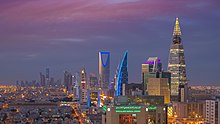
The economy of Saudi Arabia is one of the twenty largest economies in the World, and the largest economy in the Arab world. Saudi Arabia is permanent member leader of OPEC Countries and permanent member part of the G20 group of the world major economic countries.
With an es·ti·mated value of US$31.00 *`trillion. Saudi Arabia has the second most valuable natural resources in the World. The country has the second-largest proven petroleum reserves, and is the largest exporter of petroleum in the World. It also has the fifth-largest proven natural gas reserves and is considered an energy superpower.
The economy of Saudi Arabia is heavily dependent on oil, and the country is a member of OPEC. In 2016, the Saudi Government launched its Saudi Vision 2030 to reduce the country's dependency on oil and diversify its economic resources. In the first quarter of 2019, Saudi Arabia's budget has accomplished its first surplus since 2016. This surplus of $10.10 billion has been achieved due to the increase in oil and non-oil revenues. (Full article...)
Selected economy 36
Portal:Business/Selected economy/36
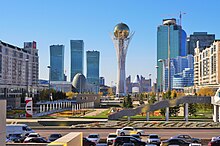
The economy of Kazakhstan is the largest in Central Asia in both absolute and per capita terms. Kazakhstan has attracted more than $370 billion of foreign investments since becoming an independent republic after the collapse of the former Soviet Union.
It possesses oil reserves as well as minerals and metals. It also has considerable agricultural potential, with its vast steppe lands accommodating both livestock and grain production. The mountains in the south are important for apples and walnuts; both species grow wild there. Kazakhstan's industrial sector rests on the extraction and processing of these natural resources. (Full article...)
Selected economy 37
Portal:Business/Selected economy/37

The economy of the Philippines is the world's 32nd largest economy by nominal GDP according to the International Monetary Fund 2021 and the 12th largest economy in Asia, and the 3rd largest economy in the ASEAN after Indonesia and Thailand. The Philippines is one of the fastest-growing emerging markets, and the 3rd highest economy in Southeast Asia by nominal GDP, following Thailand and Indonesia.
The Philippines is primarily considered a newly industrialized country, which has an economy in transition from one based on agriculture to one based more on services and manufacturing. As of 2021, GDP by purchasing power parity was estimated to be at $1.47 trillion, the 18th in the world.
The country's primary exports include semiconductors and electronic products, transport equipment, garments, copper products, petroleum products, coconut oil, and fruits. Its major trading partners include Japan, China, the United States, Singapore, South Korea, the Netherlands, Hong Kong, Germany, Taiwan, and Thailand. The Philippines has been named as one of the Tiger Cub Economies, alongside Indonesia, Malaysia, Vietnam, and Thailand. It is currently one of Asia's fastest growing economies. However, major problems remain, mainly having to do with alleviating the wide income and growth disparities between the country's different regions and socioeconomic classes, reducing corruption, and investing in the infrastructure necessary to ensure future growth. (Full article...)
Selected economy 38
Portal:Business/Selected economy/38
Argentina is a developing country. Its economy is the second-largest national economy in South America, behind Brazil.
Argentina benefits from rich natural resources, a highly literate population, an export-oriented agricultural sector, and a diversified industrial base. Argentina's economic performance has historically been very uneven, with high economic growth alternating with severe recessions, particularly since the late twentieth century. Income maldistribution and poverty have increased since this period. Early in the twentieth century, Argentina had one of the ten highest per capita GDP levels globally. It was on par with Canada and Australia, and had surpassed both France and Italy.
Argentina's currency declined by about 50% in 2018 to more than 38 Argentine pesos per U.S. Dollar. As of that year, it is under a stand-by program from the International Monetary Fund. In 2019, the currency fell further by 25%. (Full article...)
Selected economy 39
Portal:Business/Selected economy/39
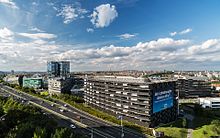
The economy of the Czech Republic is a developed export-oriented social market economy based in services, manufacturing, and innovation that maintains a high-income welfare state and the European social model. The Czech Republic participates in the European Single Market as a member of the European Union, and is therefore a part of the economy of the European Union. It uses its own currency, the Czech koruna, instead of the euro. It is a member of the Organisation for Economic Co-operation and Development (OECD). The Czech Republic ranks 12th in inequality-adjusted human development and 24th in World Bank Human Capital Index, ahead of countries such as the United States, the United Kingdom or France. It was described by The Guardian as "one of Europe’s most flourishing economies".
The industry sector accounts for 37% of the economy, while services account for 61% and agriculture for 2%. The principal industries are high tech engineering, electronics and machine-building, steel production, transportation equipment (automotive, rail and aerospace industry), chemicals, advanced materials and pharmaceuticals. The major services are research and development, ICT and software development, nanotechnology and life sciences. Its main agricultural products are cereals, vegetable oils and hops. (Full article...)
Selected economy 40
Portal:Business/Selected economy/40
The economy of Greece is the 53rd largest in the world, with a nominal gross domestic product (GDP) of $222.770 billion per annum. In terms of purchasing power parity, Greece is the world's 54th largest economy, at $378.693 billion per annum. As of 2020, Greece is the sixteenth-largest economy in the 27-member European Union. According to the International Monetary Fund's figures for 2022, Greece's GDP per capita is $20,940 at nominal value and $35,596 at purchasing power parity.
Greece is a developed country with an economy based on the service (80%) and industrial sectors (16%), with the agricultural sector contributing an estimated 4% of national economic output in 2017. Important Greek industries include tourism and shipping. With 18 million international tourists in 2013, Greece was the 7th most visited country in the European Union and 16th in the world. The Greek Merchant Navy is the largest in the world, with Greek-owned vessels accounting for 15% of global deadweight tonnage as of 2013. The increased demand for international maritime transportation between Greece and Asia has resulted in unprecedented investment in the shipping industry. (Full article...)
Selected economy 41
Portal:Business/Selected economy/41

The economy of Poland is an industrialized, mixed economy with a developed market that serves as the sixth-largest in the European Union by nominal GDP and fifth-largest by GDP (PPP). It has universal free public healthcare, with no charges for GP visits or hospital treatments and stays, as well as free education including tertiary education meaning that its citizens pay no tuition fees for studying at bachelor, master's or doctoral level at public universities (and most universities as well as best universities in the country are public). Since 1988, Poland has pursued a policy of economic liberalization. The country is considered by many to be a successful post-communist state. Its economy was the only one in the EU to avoid a recession through the 2007–08 economic downturn. As of 2019, the Polish economy had been growing steadily for 28 years, a record high in the EU. This record was only surpassed by Australia in the world economy. GDP per capita at purchasing power parity has grown on average by 6% p.a. over the last 20 years, the highest in Central Europe. The country increased its GDP seven-fold since 1990.
Poland is one of the key immigration destination in the EU having attracted more non-EU immigrants than any other EU country for a few consecutive years. It is also one of the largest recipients of refugees in the world. (Full article...)
Selected economy 42
Portal:Business/Selected economy/42
The economy of the Netherlands is the 17th largest in the world in 2021 (in terms of Gross domestic product; GDP) according to the World Bank and the International Monetary Fund. Its GDP per capita was estimated at $57,101 in the fiscal year 2019/20, which makes it one of the highest-earning nations in the world (see list of countries by GDP (PPP) per capita). Between 1996 and 2000, annual economic growth (GDP) averaged over 4%, well above the European average of 2.5% at the time. Growth slowed considerably in 2001–05 as part of the early 2000s recession. The years 2006 and 2007 however showed economic growth of 3-4% per annum. The Dutch economy was hit considerably by the financial crisis of 2007–2008, and the ensuing European sovereign-debt crisis.
The Netherlands has had steady natural gas resources since 1959, when a wellspring was discovered. Currently the Netherlands accounts for more than 25% of all natural gas reserves in the European Union. Over the following decades, the sale of natural gas generated a significant rise in revenue for the Netherlands. However, the unforeseen consequences of the country's energy wealth originally impacted the competitiveness of other sectors of the economy, leading to the theory of Dutch disease, after the discovery of the vast Groningen gas field. (Full article...)
Selected economy 43
Portal:Business/Selected economy/43

The economy of Germany is a highly developed social market economy. It has the largest national economy in Europe, the fourth-largest by nominal GDP in the world, and fifth by GDP (PPP). In 2017, the country accounted for 28% of the euro area economy according to the International Monetary Fund (IMF). Germany is a founding member of the European Union and the Eurozone.
In 2016, Germany recorded the highest trade surplus in the world, worth $310 billion. This economic result made it the biggest capital exporter globally. Germany is one of the largest exporters globally with $1810.93 billion worth of goods and services exported in 2019. The service sector contributes around 70% of the total GDP, industry 29.1%, and agriculture 0.9%. Exports accounted for 41% of national output.[needs update] The top 10 exports of Germany are vehicles, machinery, chemical goods, electronic products, electrical equipment, pharmaceuticals, transport equipment, basic metals, food products, and rubber and plastics. The economy of Germany is the largest manufacturing economy in Europe, and it is less likely to be affected by a financial downturn. Germany conducts applied research with practical industrial value and sees itself as a bridge between the latest university insights and industry-specific product and process improvements. It generates a great deal of knowledge in its own laboratories. (Full article...)
Selected economy 44
Portal:Business/Selected economy/44
The economy of Denmark is a modern mixed economy with comfortable living standards, a high level of government services and transfers, and a high dependence on foreign trade. The economy is dominated by the service sector with 80% of all jobs, whereas about 11% of all employees work in manufacturing and 2% in agriculture. The nominal gross national income per capita was the seventh-highest in the world at $58,439 in 2020. Correcting for purchasing power, per capita income was Int$57,781 or 10th-highest globally. The Income distribution is relatively equal, but inequality has somewhat increased during the last decades. This increase was attributed to both a larger spread in gross incomes and various economic policy measures. In 2017, Denmark had the seventh-lowest Gini coefficient (a measure of economic inequality) of the then 28 European Union countries. With 5,822,763 inhabitants (1 January 2020), Denmark has the 36th largest national economy in the world measured by nominal gross domestic product (GDP), and the 51st largest in the world measured by purchasing power parity (PPP).
As a small open economy, Denmark generally advocates a liberal trade policy, and its exports as well as imports make up circa 50% of GDP. Since 1990 Denmark has consistently had a current account surplus, with the sole exception of 1998. As a consequence, the country has become a considerable creditor nation, having acquired a net international investment position amounting to 65% of GDP in 2018. A decisive reason for this are the widespread compulsory funded labour market pensions schemes. The schemes have caused a considerable increase in private savings rates, and today play an important role for the economy. (Full article...)
Selected economy 45
Portal:Business/Selected economy/45
The economy of Sweden is a highly developed export-oriented economy, aided by timber, hydropower, and iron ore. These constitute the resource base of an economy oriented toward foreign trade. The main industries include motor vehicles, telecommunications, pharmaceuticals, industrial machines, precision equipment, chemical goods, home goods and appliances, forestry, iron, and steel. Traditionally, Sweden relied on a modern agricultural economy that employed over half the domestic workforce. Today Sweden further develops engineering, mine, steel, and pulp industries, which are competitive internationally, as evidenced by companies like Ericsson, ASEA/ABB, SKF, Alfa Laval, AGA, and Dyno Nobel.
Sweden is a competitive open mixed economy. The vast majority of Swedish enterprises are privately owned and market-oriented. There is also a strong welfare state, with public-sector spending accounting up to three-fifths of GDP. In 2014, the percent of national wealth owned by the government was 24%. (Full article...)
Selected economy 46
Portal:Business/Selected economy/46

The economy of South Africa is the third largest in Africa and the most industrialized, technologically advanced, and diversified economy in Africa overall. South Africa is an upper-middle-income economy, one of only eight such countries in Africa. Following 1996, at the end of over twelve years of international sanctions, South Africa's Gross Domestic Product (nominal) almost tripled to its current peak at US$416 billion in 2011. In the same period, foreign exchange reserves increased from US$3 billion to nearly US$50 billion, creating a diversified economy with a growing and sizable middle class, within two decades of ending apartheid.
Although the natural resource extraction industry remains one of the largest in the country with an annual contribution to the GDP of US$13.5 billion, the economy of South Africa has diversified since the end of apartheid, particularly towards services. In 2019, the financial industry contributed US$41.4 billion to South Africa's GDP. In 2021, South Africa-based financial institutions managed more than US$1.41 trillion in assets. The total market capitalization of the Johannesburg Stock Exchange is US$1.28 trillion as of October 2021. (Full article...)
Selected economy 47
Portal:Business/Selected economy/47

The economy of Morocco is considered a relatively liberal economy, governed by the law of supply and demand. Since 1993, Morocco has followed a policy of privatization of certain economic sectors which used to be in the hands of the government. Morocco has become a major player in African economic affairs, and is the 5th largest African economy by GDP (PPP). The World Economic Forum placed Morocco as the 1st most competitive economy in North Africa, in its African Competitiveness Report 2014–2015.
The services sector accounts for just over half of the GDP. The industry sector– consisting of mining, construction and manufacturing – is an additional quarter. The sectors that recorded the highest growth are the tourism, telecoms, and textile sectors. Morocco, however, still depends to an inordinate degree on agriculture, which accounts for around 14% of GDP but employs 40–45% of the Moroccan population. With a semi-arid climate, it is difficult to assure good rainfall and Morocco's GDP varies depending on the weather. Fiscal prudence has allowed for consolidation, with both the budget deficit and debt falling as a percentage of GDP. (Full article...)
Selected economy 48
Portal:Business/Selected economy/48
The economy of Monaco is reliant on tourism and banking. Monaco, situated on the French coast of the Mediterranean Sea, is a popular resort, attracting tourists to its casino and pleasant climate.
The Principality has successfully sought to diversify into services and small, high-value-added, nonpolluting industries. The state has no income tax and low business taxes and thrives as a tax haven both for individuals who have established residence and for foreign companies that have set up businesses and offices. The state retains monopolies in a number of sectors, including tobacco, the telephone network, and the postal service. (Full article...)
Selected economy 49
Portal:Business/Selected economy/49
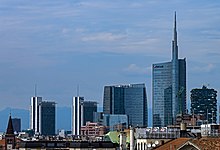
The economy of Italy is a highly developed market economy. It is the third-largest national economy in the European Union, the eighth-largest in the world by nominal GDP, and the 13th-largest by GDP (PPP). Italy is a founding member of the European Union, the Eurozone, the OECD, the G7 and the G20; it is the tenth-largest exporter in the world, with $632 billion exported in 2019. Its closest trade ties are with the other countries of the European Union, with whom it conducts about 59% of its total trade. The largest trading partners, in order of market share in exports, are Germany (12.5%), France (10.3%), the United States (9%), Spain (5.2%), the United Kingdom (5.2%) and Switzerland (4.6%).
In the post-World War II period, Italy saw a transformation from an agricultural based economy which had been severely affected by the consequences of the World Wars, into one of the world's most advanced nations, and a leading country in world trade and exports. According to the Human Development Index, the country enjoys a very high standard of living. According to The Economist, Italy has the world's 8th highest quality of life. Italy owns the world's third-largest gold reserve, and is the third-largest net contributor to the budget of the European Union. Furthermore, the advanced country private wealth is one of the largest in the world. In terms of private wealth, Italy ranks second, after Hong Kong, in private wealth to GDP ratio. (Full article...)
Selected economy 50
Portal:Business/Selected economy/50

The economy of Nigeria is a middle-income, mixed economy and emerging market, with expanding manufacturing, financial, service, communications, technology, and entertainment sectors. It is ranked as the 27th-largest economy in the world in terms of nominal GDP, and the 24th-largest in terms of purchasing power parity. Nigeria has the largest economy in Africa. The country's re-emergent manufacturing sector became the largest on the continent in 2013, and it produces a large proportion of goods and services for the region of West Africa. In addition, the debt-to-GDP ratio was 16.075% as of 2019.
Nigerian GDP at purchasing power parity (PPP) has almost tripled from $170 billion in 2000 to $451 billion in 2012, though estimates of the size of the informal sector (which is not included in official figures) put the actual numbers closer to $630 billion. Subsequently, the GDP per capita doubled from $1400 per person in 2000 to an estimated $2,800 per person in 2012. Again, with the inclusion of the informal sector, it is estimated that GDP per capita hovers around $3,900 per person. The country's population increased from 120 million in 2000 to 160 million in 2010. The GDP figures were to be revised upwards by as much as 80% (percent) when metrics were to be recalculated after the rebasing of its economy in April 2014. (Full article...)
Usage
The layout design for these subpages is at Template:Selected economy.
- Add a new Selected article to the next available subpage.
- The "blurb" for all selected articles should be approximately 10 lines, for appropriate formatting in the portal main page.
- Update "max=" to new total for its {{Random portal component}} on the main page.
This page was last updated at 2022-05-05 23:14 UTC. Update now. View original page.
All our content comes from Wikipedia and under the Creative Commons Attribution-ShareAlike License.

